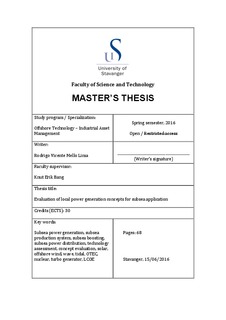| dc.contributor.advisor | Bang, Knut Erik | |
| dc.contributor.author | Lima, Rodrigo Vicente Mello | |
| dc.coverage.spatial | Norway | nb_NO |
| dc.date.accessioned | 2016-09-28T12:46:59Z | |
| dc.date.available | 2016-09-28T12:46:59Z | |
| dc.date.issued | 2016-06 | |
| dc.identifier.uri | http://hdl.handle.net/11250/2411435 | |
| dc.description | Master's thesis in Offshore technology : Industrial asset management | nb_NO |
| dc.description.abstract | The demand for oil & gas resources is forecasted to continue increasing in the next decades. And, since most of the potential onshore areas for exploration are already under production, most of the new discoveries to be done are offshore, in deeper water depths and longer step-outs from land.
Subsea located equipment for control and monitoring of the oil & gas production require supply of electrical power for remote operation of control valves, monitoring of fluid pressure, temperature and flow. Power is typically supplied from an offshore platform or from a land based facility through a subsea umbilical. One alternative configuration is the installation of the power generation equipment close to the consumers, avoiding the use of long and expensive umbilicals and reducing the area needed for power generation equipment in the platforms, among other advantages that can save capital and operation costs.
By reviewing the available power generation technologies for powering subsea production equipmant, ranking them according to a set of parameters, selecting the most feasible concepts and evaluating the cost of these concepts in different subsea cases; this thesis identifies the power generation technologies most suitable for the subsea application. Energy storage technologies are also briefly screened for the subsea application and recommendation is done on the use of a specific one.
The Levelised Cost of Electricity (LCOE) is used to define the most cost effective technology for four different subsea cases (operation of a SSIV, operation of a single subsea well, operation of 8 subsea wells and operation of a subsea boosting station).
It is observed that there is technology available, with high readiness level, that can power subsea equipment, as an alternative to powering from the topside facilities of the platform or from onshore facilities, with considerable cost saving, also solving some other technical challenges faced in long tie-backs and in platform space management. | nb_NO |
| dc.language.iso | eng | nb_NO |
| dc.publisher | University of Stavanger, Norway | nb_NO |
| dc.relation.ispartofseries | Masteroppgave/UIS-TN-IKM/2016; | |
| dc.rights | Navngivelse 3.0 Norge | * |
| dc.rights.uri | http://creativecommons.org/licenses/by/3.0/no/ | * |
| dc.subject | subsea power generation | nb_NO |
| dc.subject | subsea production system | nb_NO |
| dc.subject | subsea power distribution | nb_NO |
| dc.subject | technology assessment | nb_NO |
| dc.subject | concept evaluation | nb_NO |
| dc.subject | LCOE | nb_NO |
| dc.subject | offshore teknologi | nb_NO |
| dc.subject | industrial asset management | nb_NO |
| dc.subject | driftsledelse | nb_NO |
| dc.title | Evaluation of local power generation concepts for subsea application | nb_NO |
| dc.type | Master thesis | nb_NO |
| dc.subject.nsi | VDP::Technology: 500::Marine technology: 580::Offshore technology: 581 | nb_NO |
| dc.source.pagenumber | 68 | nb_NO |

